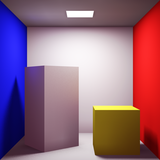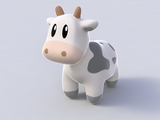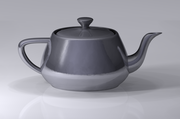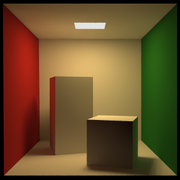This is a list of models and meshes commonly used in 3D computer graphics for testing and demonstrating rendering algorithms and visual effects. Their use is important for comparing results, similar to the way standard test images are used in image processing.
Modelled
Designed using CAD software; sorted by year of modelling.
| Name and viewer | Render | Year of creation | Person/organisation that did the modelling | Description of source object | Model size | License | Comments |
|---|---|---|---|---|---|---|---|
| Utah teapot |  |
1975 | Martin Newell at University of Utah | Melitta teapot | 28 Bézier patches (32 with the bottom) | Also called the "Newell teapot". One of the first models not to be measured. | |
| Cornell box |  |
1984 | Cindy M. Goral, Kenneth E. Torrance, Donald P. Greenberg, Bennett Battaile at Cornell University | Originally meant to be compared to real-life setup to test physicality of simulated optics | 5 quads, 1 light source | Scene includes multiple models and light source. Many versions exist, but only one of them is considered the standard Cornell box; the color of the left and right walls is important. | |
| Suzanne |  |
2002 | Willem-Paul van Overbruggen for Blender | Chimpanzee head, based on an orangutan from the movie Jay and Silent Bob Strike Back | 500 faces | GNU GPL 2+ (inherited from Blender as a whole) | Mascot for Blender |
| Crytek Sponza | 2010 | Frank Meinl at Crytek | The colonnaded atrium of the Sponza Palace in Dubrovnik | 262,267 triangles 184,330 vertices |
Used for demonstrating global illumination techniques. The Crytek version is based on a model created by Marko Dabrović in early 2001 while he was at RNA studio, and donated to a radiosity competition held by CGTechniques.com in early 2002. | ||
| Spot |  |
2012 | Keenan Crane at Caltech | cartoon cow | 2,930 vertices 5,856 triangles |
Catmull-Clark control mesh, quadrangulation, triangulation, vector texture, and bitmap texture. All meshes are manifold, genus-0 embeddings. | |
| 3DBenchy |  |
2015 | Creative Tools | cartoon boat | 112,569 verts (225,154 tris) | CC By ND 4.0 | Specifically designed for testing the accuracy and capabilities of 3D printers |
Scanned
Includes photogrammetric methods; sorted by year of scanning.
| Name and viewer | Render | Year of creation | Person/organisation responsible for the scan | Description of source object | Model size | License | Comments |
|---|---|---|---|---|---|---|---|
| Stanford bunny |  |
1993-94 | Greg Turk, Marc Levoy at Stanford University | Ceramic rabbit | 69,451 triangles | Figurine of unknown authorship and licensing status, scan itself released under a two-clause BSD license. | A test of range scanning physical objects. Originally .ply file. |
| Stanford dragon |  |
1996 | Stanford University | Chinese dragon | 1,132,830 triangles | ||
| Stanford Armadillo |  |
1996 | Venkat Krishnamurthy and Marc Levoy at Stanford University | Armadillo action figure | 345,944 triangles | Free for scholarly writings and research, attribution required, no commercial use without prior permission | |
| Wooden Elk Toy | 2000 | Hans-Peter Seidel at Max-Planck-Institut für Informatik | Often used as an example of a non-trivial object with high genus. | ||||
| Phlegmatic Dragon |  |
2007 | Academy of Sciences of the Czech Republic, Czech Technical University in PragueEurographics 2007 conference | 667,214 faces (original) 480,076 faces (smoothed) |
Sticker on the bottom says "GRUNCH © PANTON '88 MADE IN ENGLAND" | Smoothed and nonsmoothed | |
| David | 2009 | Stanford University | Michelangelo's 5-meter statue David | ~1 billion polygons | Only available to established scholars and for non-commercial use only. | range data | |
| Fertility | 2009 | AIM@SHAPE Repository (scanned at Utrecht University) | Small stone statue with two joined figures. | 241,607 vertices 483,226 triangles |
Laser scan. | ||
| Nefertiti | 
|
2015 | Nora Al-Badri and Jan Nikolai Nelles | A stoneworked bust of the Egyptian queen Nefertiti was created in 1345 BC by Thutmose | ~2 million triangles | CC By SA 4.0 | Surreptitiously scanned by Nora Al-Badri and Jan Nikolai Nelles, and subsequently separately by Scan the World with permission of the Neues Museum. |
Gallery
-
 The Utah teapot (1975) has a "hole" in it so it has a genus greater than zero.
The Utah teapot (1975) has a "hole" in it so it has a genus greater than zero.
-
 The Cornell box (1985) tests lighting and rendering.
The Cornell box (1985) tests lighting and rendering.
-
 A 3D-printed reproduction of Stanford dragon (1996) physical model, made through rapid prototyping
A 3D-printed reproduction of Stanford dragon (1996) physical model, made through rapid prototyping
-
 Suzanne (2002) with wireframe
Suzanne (2002) with wireframe
-
 Spot (2012) shown homeomorphic to a sphere
Spot (2012) shown homeomorphic to a sphere
-
 3DBenchy (2015), designed to test 3D printing
3DBenchy (2015), designed to test 3D printing
See also
- Standard test image – Digital image used to test image algorithms
- A Computer Animated Hand – 1972 film by Edwin CatmullPages displaying wikidata descriptions as a fallback
- Sutherland's Volkswagen – 3D test model
References
- "The Utah Teapot". holmes3d.net. Retrieved 2020-10-28.
- Primitive instantiable by clicking Add → Mesh → Monkey
- ^ Morgan McGuire. "McGuire Computer Graphics Archive".
- Jennifer O'Connor (1 July 2010). Mastering mental ray: Rendering Techniques for 3D and CAD Professionals. John Wiley & Sons. p. 175. ISBN 978-0470563854.
The Sponza Palaze atrium scene has become a classic demonstration model for indirect illumination techniques in a wide variety of applications
- Robert McMillan (24 September 2014). "Nvidia Proves We Walked on the Moon—Not That It Needed To". Wired.
It cooked up a demo using a standard graphics simulation called the Sponza Atrium, a computer-generated stroll through a renaissance-style hallway.
- Matt Pharr; Greg Humphreys (26 August 2010). Physically Based Rendering: From Theory to Implementation. Morgan Kaufmann. p. 493. ISBN 978-0123750792.
- Jaroslav Krivanek; Pascal Gautron (2009). Practical Global Illumination with Irradiance Caching. Morgan & Claypool Publishers. p. 85. ISBN 978-1598296440.
- Abecassis, Laurent (3 April 2001). "On The Web – RNA studio's GI architectural renderings". CGPress. Archived from the original on 4 June 2021. Retrieved 4 June 2021.
- "Sponza Atrium - Hatch Studios". Hatch Studios. Archived from the original on 25 February 2021. Retrieved 4 June 2021.
- "License - 3DBenchy.com". 7 April 2015. Retrieved 29 March 2022.
- ^ "The Stanford 3D Scanning Repository". Stanford University. 22 Dec 2010. Retrieved 17 July 2011.
- Greg Turk (2000). "The Stanford Bunny". Retrieved 18 July 2011.
- Michael Goesele; Wolfgang Heidrich; Hendrik P. A. Lensch; Hans-Peter Seidel (January 2000). "Building a Photo Studio for Measurement Purposes". Computer Graphics Group, Max-Planck-Institut fur Informatik. CiteSeer: 10.1.1.18.3510.
- "EG 2007 Phlegmatic Dragon". Eurographics 2007. 12 May 2011. Retrieved 23 July 2011.
- ^ Levoy, Marc (August 11, 2009). "The Digital Michelangelo Project". Stanford University. Retrieved 22 September 2014.
- ^ Levoy, Marc (August 19, 2014). "The Digital Michelangelo Project Archive of 3D Models". Stanford University. Retrieved 22 September 2014.
- Levoy, Marc (November 27, 1998). "The Stanford Large Statue Scanner". Stanford University. Retrieved 22 September 2014.
External links
- Standard test models
- The Stanford 3D Scanning Repository hosted by the Stanford University
- Large Geometric Models Archive hosted by the Georgia Institute of Technology
- Other repositories
- The Utah 3D Animation Repository, a small collection of animated 3D models
- scene collection, by Physically Based Rendering Toolkit: a number of interesting scenes to render with global illumination
- MGF Example Scenes, a small collection of some indoor 3D scenes
- archive3D, a collection of 3D models
- 3DModels, a collection of vehicle 3D models
- 3DBar, a collection of free 3D models
- NASA 3D Models, NASA 3D models to use for educational or informational purposes
- VRML Models from ORC Incorporated, 3D models in VRML format
- 3dRender.com: Lighting Challenges, regularly held lighting challenges, complete with scene and models for each challenge
- MPI Informatics Building Model, a virtual reconstruction of the Max Planck Institute for Informatics building in Saarbrücken
- Princeton shape-based 3D model search engine
- Keenan's 3D Model Repository hosted by the Carnegie Mellon University
- HeiCuBeDa Hilprecht – Heidelberg Cuneiform Benchmark Dataset for the Hilprecht Collection a collection of almost 2.000 cuneiform tablets for bulk-download acquired with a high-resolution 3D-scanner. Available under a CC BY license and quotable by digital object identifiers. Datasets cleaned using the GigaMesh Software Framework.
- HeiCu3Da Hilprecht – Heidelberg Cuneiform 3D Database - Hilprecht Collection browsable version of HeiCuBeDa allowing to download and quote single 3D models.